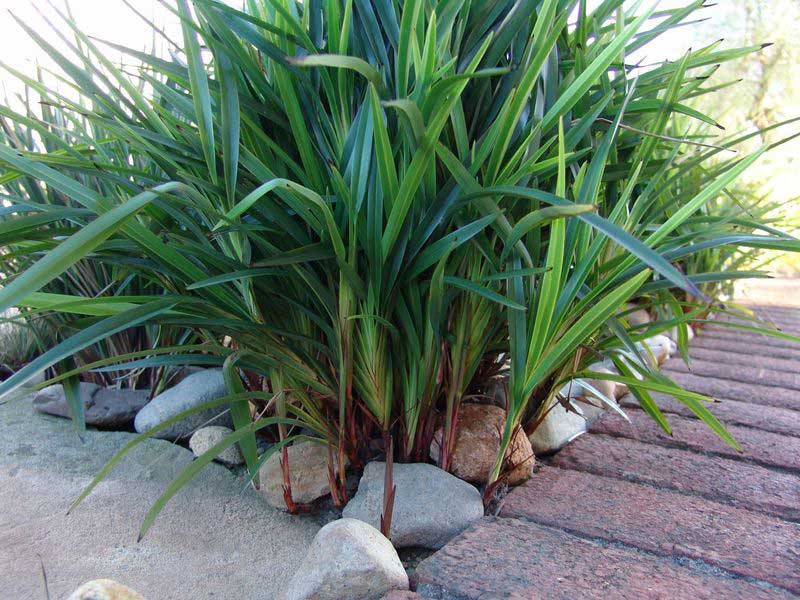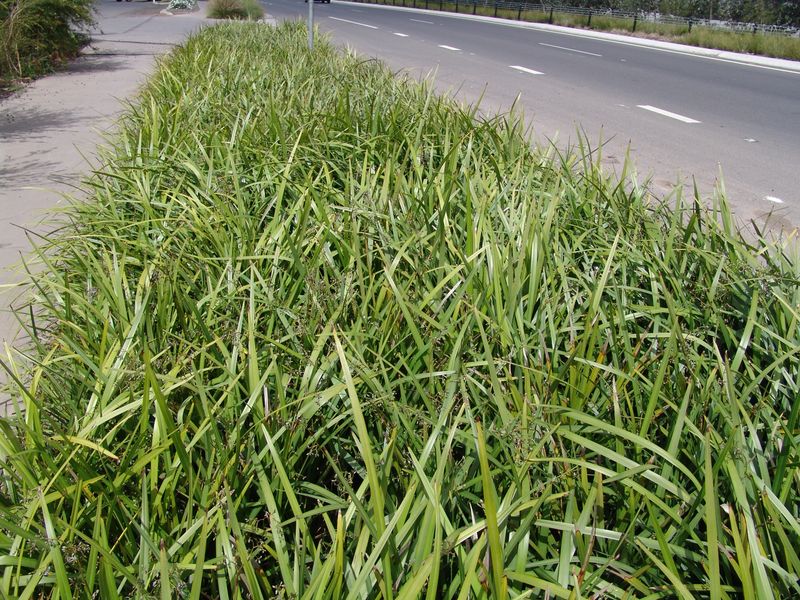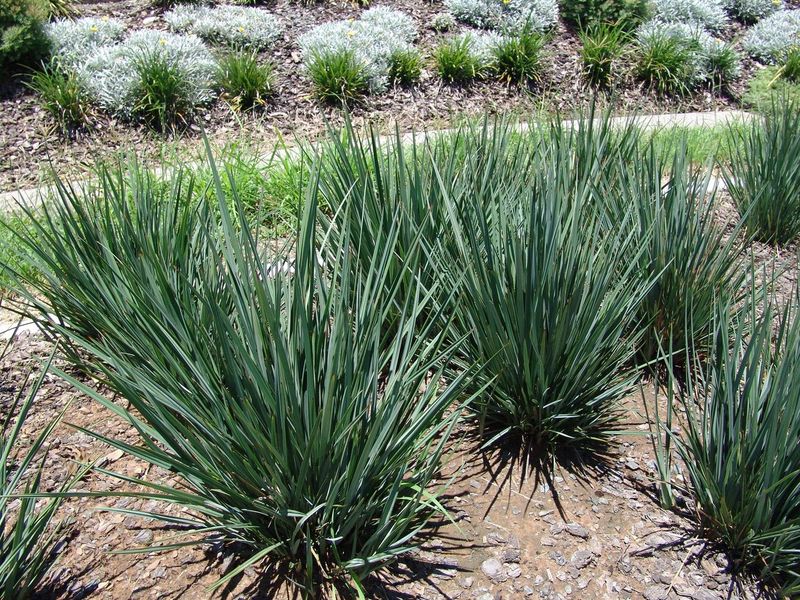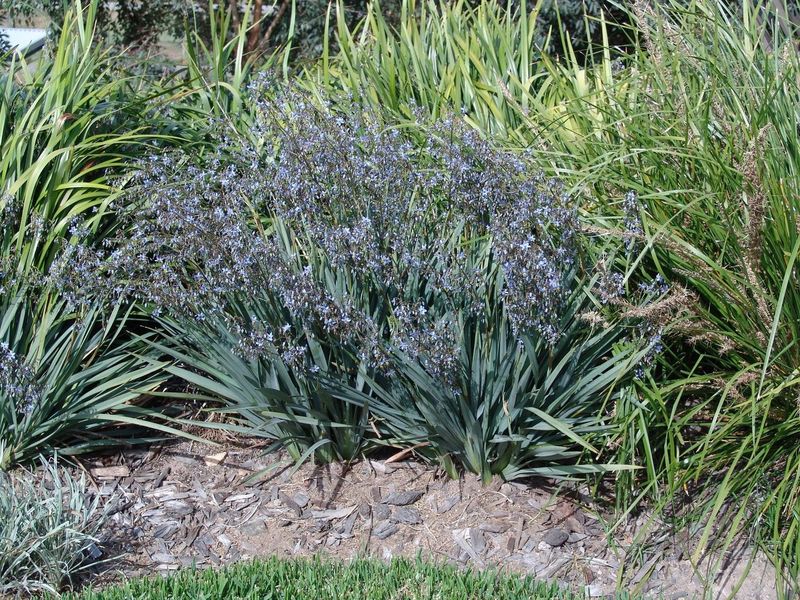Are you looking for resilient, attractive plants to enhance your urban landscape? Have you considered the remarkable versatility and beauty of Dianella cultivars? In this article, we dive into six of our most popular Dianella varieties, showcasing why they have become favourites among landscape architects, designers, and experienced home gardeners alike.
Dianellas are incredible plants that deserve to be celebrated. This one is Little Jess Dianella, which you’ll learn more about below.
Why Choose Dianella for Your Landscape?
Dianellas, commonly referred to as flax lilies, are a testament to the adaptability and aesthetic appeal that every modern landscape craves. But every species and variety performs their own way. It’s important to choose good genetic stock if you want to boost survival rates after planting because dead plants need replacing, which means spending more money on more plants and labour.
Before we get to our most popular six Dianellas, let’s explore why the genus is even worth looking at in the first place.
Adapting to Urban Challenges
Dianellas excel in urban environments, showing remarkable resilience against common urban challenges such as pollution, compacted soils, and varying light conditions. Their robust nature allows them to thrive where other plants might struggle, making them an excellent choice for cityscapes seeking greenery that lasts.
Because they require less irrigation, fertilisers and pest control, they’re one of the most sustainable and environmentally-friendly plant choices that you can make.
Buzz Pollinators
Dianellas are particularly attractive to our native buzz pollinators, like the incredibly charismatic blue-banded bee. Planting dianellas not only adds beauty and resilience to your landscape but also supports local biodiversity by providing a food source for these vital pollinators.
Low Maintenance, High Reward
The care for Dianellas is remarkably straightforward, focusing on their drought tolerance and minimal pruning requirements. Whether you opt to remove dead leaves and heads to maintain a tidy appearance or allow the plant to take on a more natural, wild look, some varieties may need a hard prune every few years to ensure their longevity.
Meet Our Top 6 Dianella Cultivars
Little Jess™ Dianella caerulea ‘DCMP01’ (PBR)
Little Jess™ Dianella stands out for its compact growth, making it an ideal choice for smaller spaces or as a border plant. It’s a dwarf variety with short, compact canes that do not fall over. This plant is particularly low maintenance, requiring trimming approximately every 8 years. It thrives in both full sun and moderate to heavy shade, tolerating drought, humidity, and frost well. Little Jess™ is distinguished by its masses of purple flowers, which bloom from September to November, and its exceptional drought tolerance compared to other Dianella caerulea varieties. Suitable for a wide range of soils, except very poor ones, it’s ideal for specimen and mass plantings in both commercial and residential settings.
Little Jess Dianella is our most popular dianella ever. https://www.ozbreed.com.au/plant-ranges/strappy-leaf-plants/little-jess-dianella/

Tasred® Dianella tasmanica ‘TR20’ PBR
Tasred® Dianella stands out for its vibrant, year-round foliage colour and its ability to produce a profusion of purple and yellow flowers in spring, followed by attractive purple berries. It reaches a size of approximately 60cm in height and width, making it slightly larger than Little Jess™. Tasred® is adaptable to a variety of conditions, thriving in full sun or part shade and handling moderate frost and drought. Its striking appearance and hardiness make it suitable for mass plantings, accent gardens, and containers.
Check out the beautiful red leaf stems on Tasred Dianella. https://www.ozbreed.com.au/plant-ranges/strappy-leaf-plants/tasred-dianella/

Breeze® Dianella caerulea ‘DCNC0’ PBR
Breeze® Dianella has an incredible ability to maintain a lush, green appearance throughout the year, even under tough conditions. It grows to about 60-70cm in height and width, producing blue and yellow flowers in spring which may lead to purple berries. This variety is highly adaptable, performing well in full sun to part shade, and is tolerant of drought, frost, and coastal conditions. This versatility, along with its aesthetic appeal, makes it an excellent choice for mass plantings, borders, and erosion control.
Breeze Dianella in a roadside mass planting. https://www.ozbreed.com.au/plant-ranges/strappy-leaf-plants/breeze-dianella/

Little Rev™ Dianella revoluta ‘DR5000’ PBR
Little Rev™ Dianella has distinctive blue-grey foliage and durability, thriving in conditions where other plants might falter. Its suitability for wetter conditions and unique aesthetic make it a valuable addition to any landscape seeking texture and resilience.
Little Red with its blue-grey, sword-like foliage. https://www.ozbreed.com.au/plant-ranges/strappy-leaf-plants/little-rev-dianella/

Cassa Blue® Dianella caerulea ‘DBB03’ PBR
Cassa Blue® Dianella’s bright blue foliage and compact growth habit make it a vibrant addition to any garden or landscape. It produces attractive blue and yellow flowers followed by purple berries, adding further interest. Cassa Blue® Dianella is suitable for a wide range of conditions, including full sun and part shade, and is both drought and frost tolerant. Its versatility and striking colour make it an ideal choice for mass plantings, accent planting, and containers.
Cassa Blue Dianella in full bloom. https://www.ozbreed.com.au/plant-ranges/strappy-leaf-plants/cassa-blue-dianella/

Lucia™ Dianella caerulea ‘DC101’ PBR
Lucia™ Dianella serves as an excellent low-cost ground cover option, boasting dense growth and minimal maintenance needs. Its ability to establish quickly and provide a thick mat of foliage makes it ideal for controlling weeds and enhancing the understorey of larger plantings.
Lucia Dianella forms a dense mat of scrappy foliage with taller flower canes. https://www.ozbreed.com.au/plant-ranges/strappy-leaf-plants/lucia-dianella/

Choosing the Right Dianella for Your Project
Considerations for Selection
Selecting the most suitable Dianella variety for your landscaping project involves a nuanced understanding of the site’s specific conditions and the functional requirements of the space. Here are key factors to consider:
- Location and Climate: Evaluate the climate zone of your project area. Some Dianella species thrive in cooler temperate climates, whereas others are suited to warmer, subtropical environments. Understanding your climate and micro climates can narrow down your choices significantly.
- Soil Type: Dianellas generally prefer well-drained soils but some can adapt to a range of soil types. Assessing the soil texture will help identify if any amendments are necessary before planting.
- Intended Use: Define the primary purpose(s) of incorporating Dianellas into your landscape. Whether it’s for erosion control, as a ground cover, for aesthetic foliage, or for attracting wildlife, each variety offers distinct advantages. For example, Little Jess Dianella is excellent for borders due to its compact growth, while Little Rev Dianella can handle wetter conditions, making it a better option for the raised parts of bio swales.
Planting and Care Tips
For successful establishment and growth of dianellas, consider the following tips:
- Planting Time: The best time to plant dianellas is during the milder months of spring or autumn, which reduces stress on the plants and supports root development.
- Soil Preparation: Incorporate organic matter into the planting site to improve soil structure and water retention. Ensure the site has good drainage to prevent root rot.
- Watering: While dianellas are drought-tolerant once established, regular watering during the first few months after planting is crucial to support their growth. Once established, they will require only occasional watering during prolonged dry spells.
- Pruning: Pruning is minimal with dianellas. Remove dead foliage and spent flower stems at the base to encourage healthy growth and maintain a tidy appearance. Some varieties may benefit from a hard prune every few years to rejuvenate the plant.
Conclusion: Elevating Your Landscape with Dianellas
Choosing dianellas for your landscaping projects offers a blend of aesthetic appeal, environmental benefits, and practicality. These versatile and resilient plants not only enhance the visual dynamics of a space but also contribute to local biodiversity, supporting a healthier environment. By considering the specific needs of your project and following practical planting and care advice, you can maximise the impact of dianellas in your landscape design.
